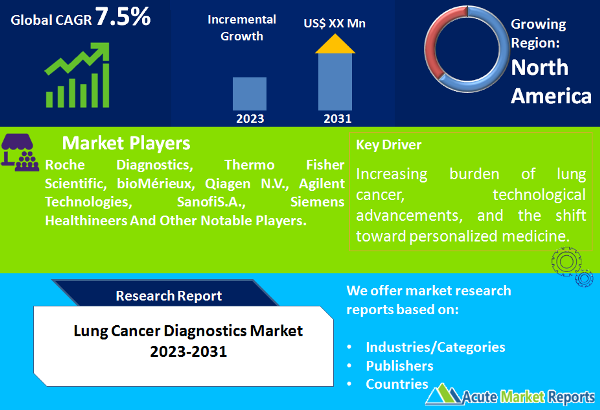
The lung cancer diagnostics market is pivotal in the early detection and management of lung cancer, a deadly disease with high mortality rates. The lung cancer diagnostics market is expected to grow at a CAGR of 7.5% during the forecast period of 2026 to 2034. The lung cancer diagnostics market plays a critical role in addressing the rising prevalence of lung cancer globally. Key drivers include the increasing burden of lung cancer, technological advancements, and the shift toward personalized medicine. Despite challenges related to costs, the market is poised for growth, with lung tissue analysis and small-cell lung cancer diagnostics expected to lead in terms of CAGR. The Asia-Pacific region is anticipated to be a significant growth driver. Leading companies are focusing on innovation, partnerships, global expansion, and patient-centered approaches to maintain their competitive edge in this dynamic market.

Rising Prevalence and Mortality of Lung Cancer
The foremost driver of the lung cancer diagnostics market is the alarming rise in the prevalence and mortality of lung cancer worldwide. Lung cancer remains one of the leading causes of cancer-related deaths, with an increasing incidence, particularly among smokers and individuals exposed to environmental carcinogens. Evidence of this can be observed in global cancer statistics, which consistently highlight lung cancer's significant burden on healthcare systems. The urgent need for early detection and timely intervention drives demand for advanced diagnostic tests.
Technological Advancements in Diagnostic Imaging
Advances in diagnostic imaging technologies, such as computed tomography (CT), magnetic resonance imaging (MRI), and positron emission tomography (PET), have revolutionized lung cancer diagnostics. These technologies allow for the early detection of tumors, accurate staging, and monitoring of treatment response. Evidence of this progress can be seen in the increasing adoption of 3D imaging techniques and artificial intelligence (AI) algorithms for image analysis, which enhance the sensitivity and specificity of lung cancer diagnostics.
Growing Emphasis on Personalized Medicine
The growing emphasis on personalized medicine and targeted therapies is another key driver. Lung cancer is not a single disease; it encompasses various subtypes, with non-small cell lung cancer (NSCLC) and small cell lung cancer (SCLC) being the most common. Advances in molecular diagnostics have enabled the identification of specific genetic mutations and biomarkers associated with different lung cancer subtypes. Evidence of this trend can be found in the increasing use of genetic testing and liquid biopsy techniques to guide treatment decisions and optimize therapeutic outcomes, which fosters growth in the lung cancer diagnostics market.
Restraint of the Lung Cancer Diagnostics Market
While the lung cancer diagnostics market is poised for growth, a significant restraint is the challenges associated with the high cost of advanced diagnostic tests and treatments. Evidence of this restraint can be observed in the financial burden on healthcare systems and patients, particularly in low- and middle-income countries. Access to cutting-edge diagnostics and targeted therapies can be limited due to cost considerations, creating disparities in lung cancer care. Addressing this restraint requires innovative pricing models, healthcare financing strategies, and global collaboration to ensure equitable access to life-saving diagnostic tools and treatments.
Market Segmentation by Diagnostic Test Type (Imaging Tests, Pulmonary Function Tests, Lung Tissue Analysis, Others): Imaging Tests Dominate the Market
In 2025, the highest revenue within the lung cancer diagnostics market was generated by imaging tests, reflecting their widespread use for screening and diagnosis. However, during the forecast period from 2026 to 2034, lung tissue analysis is expected to exhibit the highest compound annual growth rate (CAGR). This growth is attributed to advancements in biopsy techniques, including minimally invasive procedures, and the increasing demand for molecular profiling to guide treatment decisions.
Market Segmentation by Cancer Type (Non-small Cell Lung Cancer (NSCLC), Small Cell Lung Cancer (SCLC)): NSCLCDominates the Market
In 2025, NSCLC accounted for the highest revenue within the lung cancer diagnostics market, reflecting its higher prevalence compared to SCLC. However, during the forecast period from 2026 to 2034, SCLC is expected to experience the highest CAGR. This shift is driven by advancements in SCLC diagnostics and the development of targeted therapies for this aggressive cancer subtype.
North America Remains the Global Leader
Geographically, the lung cancer diagnostics market exhibits varying trends. North America has traditionally held a significant revenue share, primarily due to the early adoption of advanced diagnostic technologies and a high prevalence of lung cancer. However, the Asia-Pacific region is expected to demonstrate the highest CAGR during the forecast period. This growth is driven by factors such as a large population, rising awareness about lung cancer, and improving healthcare infrastructure. The region with the highest revenue percentage in 2025 was North America, reflecting its well-established healthcare systems. However, the Asia-Pacific region is expected to surpass North America in terms of CAGR. As governments and healthcare providers in the Asia-Pacific region prioritize cancer screening and early detection, the demand for lung cancer diagnostics is expected to surge.
Market Competition to Intensify during the Forecast Period
The lung cancer diagnostics market is highly competitive, with several key players striving to offer innovative solutions and maintain their market positions. Leading companies, including Roche Diagnostics, Thermo Fisher Scientific, bioMerieux, Qiagen N.V., Agilent Technologies, SanofiS.A. and Siemens Healthineers, employ various strategies to stay competitive in the market. Leading companies are heavily investing in research and development to introduce innovative diagnostic tools, including liquid biopsy tests, next-generation sequencing, and AI-driven diagnostic algorithms. These technologies enhance the accuracy and efficiency of lung cancer diagnostics. Companies are forming strategic partnerships and collaborations with research institutions, healthcare providers, and pharmaceutical companies to develop and commercialize new diagnostic solutions. Collaboration enables them to access complementary expertise and resources. Leading players are expanding their global presence through acquisitions and mergers, enabling them to broaden their product portfolios and reach new markets. This strategy also allows companies to diversify their revenue streams. Companies are adopting patient-centric approaches, emphasizing early detection, patient education, and personalized treatment options. This approach not only enhances patient outcomes but also strengthens brand reputation.
Historical & Forecast Period
This study report represents analysis of each segment from 2024 to 2034 considering 2025 as the base year. Compounded Annual Growth Rate (CAGR) for each of the respective segments estimated for the forecast period of 2026 to 2034.
The current report comprises of quantitative market estimations for each micro market for every geographical region and qualitative market analysis such as micro and macro environment analysis, market trends, competitive intelligence, segment analysis, porters five force model, top winning strategies, top investment markets, emerging trends and technological analysis, case studies, strategic conclusions and recommendations and other key market insights.
Research Methodology
The complete research study was conducted in three phases, namely: secondary research, primary research, and expert panel review. key data point that enables the estimation of Lung Cancer Diagnostics market are as follows:
Market forecast was performed through proprietary software that analyzes various qualitative and quantitative factors. Growth rate and CAGR were estimated through intensive secondary and primary research. Data triangulation across various data points provides accuracy across various analyzed market segments in the report. Application of both top down and bottom-up approach for validation of market estimation assures logical, methodical and mathematical consistency of the quantitative data.
| ATTRIBUTE | DETAILS |
|---|---|
| Research Period | 2024-2034 |
| Base Year | 2025 |
| Forecast Period | 2026-2034 |
| Historical Year | 2024 |
| Unit | USD Million |
| Segmentation | |
Diagnostic Test Type
|
|
Cancer Type
|
|
End-User
|
|
|
Region Segment (2024-2034; US$ Million)
|
Key questions answered in this report